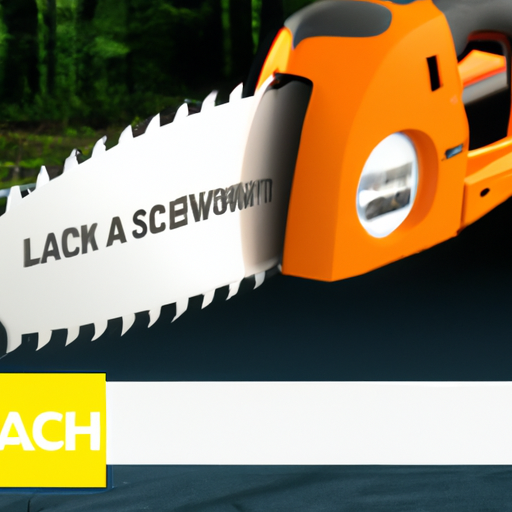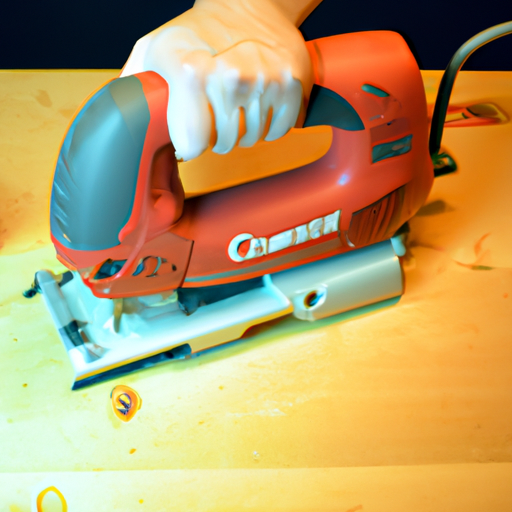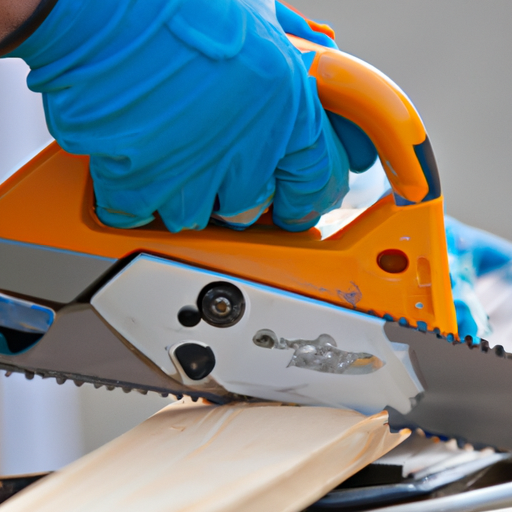Have you ever wondered how to safely operate a battery-powered circular saw? We’ve got you covered! In this article, we’ll walk you through the steps to ensure you can use this tool with confidence. Whether you’re a DIY enthusiast or a professional, it’s important to know the proper safety precautions when using power tools. So, let’s dive in and learn more about how to safely operate a battery-powered circular saw.
First and foremost, always wear personal protective equipment (PPE) when using a circular saw. This includes safety glasses, ear protection, and gloves. Safety should be your top priority, so make sure you’re properly equipped before starting any project.
Next, familiarize yourself with the saw’s components, such as the blade guard and the depth adjustment. Knowing how to use these features correctly will help prevent accidents and ensure accurate cuts. It’s also important to ensure the battery is fully charged before operating the saw. A low battery can result in decreased power and potentially dangerous situations.
Lastly, when using a circular saw, make sure to set up a stable work area and secure your materials properly. Unstable work surfaces can lead to accidents, so it’s crucial to have a stable and well-supported workbench. Additionally, always use clamps or other securing methods to keep your materials in place. This will prevent them from shifting or slipping during the cutting process.
In conclusion, operating a battery-powered circular saw can be safe and efficient if you follow the proper guidelines. By wearing the right protective gear, understanding the saw’s components, and creating a stable work environment, you’ll be on your way to successfully using this power tool. Stay tuned for our upcoming article, where we’ll provide even more tips and tricks to make the most out of your battery-powered circular saw.
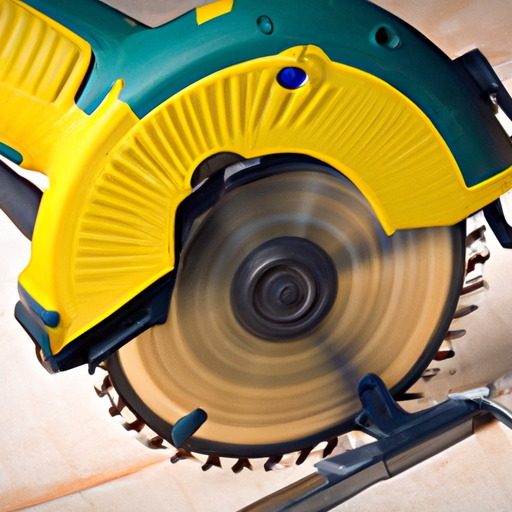
Preparation
Gathering the necessary equipment
Before using a battery-powered circular saw, it is important to gather all the necessary equipment. This includes the saw itself, a fully charged battery, a straight edge or saw guide, a protractor or angle guide (if needed), and appropriate safety gear such as safety glasses, ear protection, and gloves.
Inspecting the saw and battery
Before starting any woodworking project, it is crucial to inspect the circular saw and the battery. Check the saw for any damages or loose parts that need to be fixed before use. Inspect the battery to ensure it is fully charged and in good condition. If there are any issues, it is best to address them before using the saw.
Wearing appropriate safety gear
To ensure a safe working environment, it is essential to wear the appropriate safety gear. Safety glasses will protect your eyes from any debris generated during cutting. Ear protection should be worn to protect your hearing from the noise produced by the saw. Gloves will provide added grip and protect your hands from cuts or splinters. Always wear closed-toe shoes to protect your feet from any falling objects.
Setting Up the Work Area
Clearing the workspace
Before you begin using a battery-powered circular saw, you must clear the workspace of any clutter or obstacles. This includes removing any tools, debris, or other objects that may impede your movement or pose a safety hazard. Make sure the area is well-lit and free from tripping hazards.
Securing the workpiece
To ensure accuracy and safety while cutting, it is important to secure the workpiece properly. Use clamps or other suitable methods to secure the material being cut to a stable surface. This will prevent it from moving or sliding during the cutting process, reducing the risk of accidents.
Setting up a stable support
For longer cuts or when working with larger materials, it is advisable to set up a stable support system. This can be done using sawhorses or a workbench to provide a solid base for the workpiece. A stable support will not only make the cutting process easier but also reduce the risk of the material binding or pinching the saw blade.
Understanding the Controls
Familiarizing with the on/off switch
Before operating the battery-powered circular saw, it is important to be familiar with the location and operation of the on/off switch. This switch is used to start and stop the saw. It is usually located within easy reach of the handle for convenient operation.
Learning the different speed settings
Many battery-powered circular saws offer different speed settings to accommodate various cutting needs. Take the time to understand the different speed settings available on your saw and how they affect the cutting process. Different materials may require different speeds for optimal results.
Basic Techniques
Positioning your body and feet
To ensure stability and control while operating a battery-powered circular saw, it is important to position your body correctly. Stand with your feet shoulder-width apart and your body aligned with the cutting line. Keep your back straight and your shoulders relaxed. This will help you maintain balance and control throughout the cutting process.
Holding the saw correctly
Properly gripping the saw is crucial for both safety and accuracy. Hold the handle of the saw with one hand and place your other hand on the front of the saw, near the blade guard. This grip will provide stability and control, ensuring that the saw remains steady while cutting.
Maintaining a steady grip
While operating the saw, it is important to maintain a steady grip to prevent any sudden movements or slips. Keep your grip firm but not too tight, allowing for smooth and controlled cutting. Avoid gripping the saw too close to the blade, as this can increase the risk of accidents.
Maintaining control while cutting
To maintain control while cutting, it is essential to follow a few key techniques. Firstly, ensure that the saw blade is aligned with the cutting line. This can be done by following a mark on the workpiece or by using the saw’s guide or a straight edge as a reference. Secondly, maintain a consistent cutting speed, neither too fast nor too slow. Lastly, let the saw do the cutting by applying gentle pressure and allowing the blade to do the work.
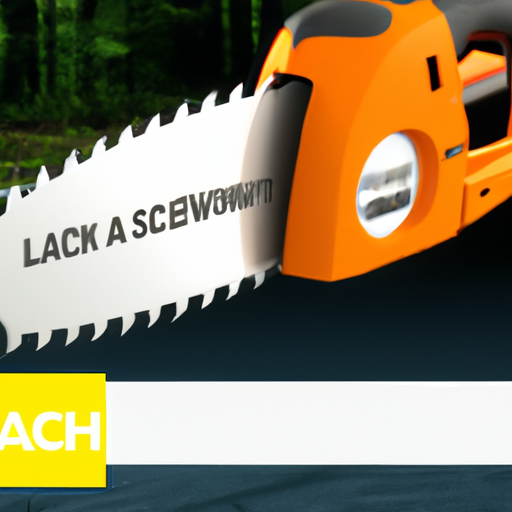
Making Straight Cuts
Marking the cut line
Before making a straight cut, it is vital to mark the cut line on the workpiece. This can be done using a pencil or a marker, ensuring that the line is clear and visible. Take the time to double-check the accuracy of the mark before proceeding with the cut.
Using the saw’s guide or a straight edge
To ensure a straight and accurate cut, it is advisable to use the saw’s guide or a straight edge as a reference. Align the saw’s guide or the straight edge with the marked cut line, ensuring that the blade is positioned correctly. This will help guide the saw along the desired cutting path, resulting in a clean and precise cut.
Making Angled Cuts
Setting the desired angle
Battery-powered circular saws often have the ability to make angled cuts. Before making such cuts, it is important to set the desired angle. This can be done by adjusting the bevel or tilt of the saw blade. Consult the saw’s manual for specific instructions on adjusting the angle.
Using a protractor or angle guide
When making angled cuts, it is helpful to use a protractor or angle guide to ensure accuracy. These tools can be used to measure and set the desired angle before making the cut. Place the protractor or angle guide against the workpiece and adjust the saw’s bevel accordingly. This will help you achieve precise angled cuts.
Avoiding Kickback
Understanding kickback
Kickback is a dangerous situation that can occur when the workpiece binds or pinches the saw blade, causing it to violently jerk back towards the operator. To avoid kickback, it is important to understand its causes and take the necessary precautions. Kickback can be caused by factors such as incorrect cutting techniques, improper blade alignment, or working with a dull blade.
Preventing kickback by using the right techniques
To prevent kickback, it is crucial to use the right cutting techniques. Firstly, always ensure that the blade is aligned correctly with the cutting line. Secondly, avoid forcing the saw through the cut, as this can cause the blade to bind or pinch. Instead, let the saw do the work by applying gentle, even pressure. Lastly, maintain control by keeping a firm and steady grip on the saw.
Changing the Blade
Switching off and disconnecting the saw
Before changing the blade on a battery-powered circular saw, it is important to switch off the saw and disconnect it from the power source. This will prevent any accidental activation of the saw while working on the blade.
Removing the old blade
To remove the old blade, locate the blade arbor lock and engage it to lock the blade in place. Then, use a wrench to loosen and remove the arbor nut. Carefully remove the old blade, taking care not to touch the sharp edges. Place the old blade in a safe location until it can be properly disposed of.
Installing the new blade
To install a new blade, ensure that it is suitable for the material you will be cutting. Align the center hole of the new blade with the arbor, then tighten the arbor nut using a wrench. Make sure the nut is securely tightened, but avoid over-tightening as this can damage the blade or the saw.
Maintenance and Care
Cleaning the saw after use
After each use, it is important to clean the battery-powered circular saw to maintain its performance and longevity. Use a brush or compressed air to remove any sawdust or debris from the saw’s body, handle, and blade. Wipe down the saw with a clean cloth to remove any remaining dust or residue.
Keeping the battery charged
To ensure that the battery-powered circular saw is always ready for use, it is essential to keep the battery charged. Follow the manufacturer’s instructions for charging the battery and avoid overcharging or leaving it on the charger for extended periods of time. Regularly check the battery’s charge level to ensure it is ready for the next project.
Inspecting and replacing worn parts
Regularly inspect the battery-powered circular saw for any signs of wear or damage. Pay special attention to the blade, blade guard, and handle. If any parts are worn, damaged, or not functioning properly, replace them immediately. Using a saw with worn or damaged parts can compromise both the safety and performance of the tool.
Conclusion
Applying safe operating practices for battery-powered circular saws ensures a smooth and accident-free woodworking experience. By following the preparation steps, setting up the work area correctly, understanding the controls, and implementing the appropriate cutting techniques, you can confidently use a battery-powered circular saw for various projects. Remember to always wear the appropriate safety gear, secure the workpiece properly, and maintain control throughout the cutting process. By prioritizing safety and following these guidelines, you can enjoy the benefits of using a battery-powered circular saw while minimizing the risk of accidents or injuries.
